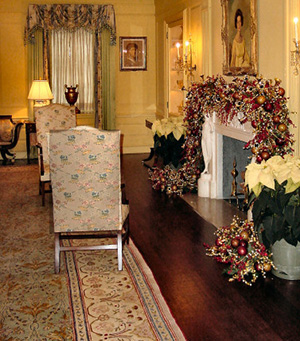2000: Bush Administration

Carpet Description
- Antique Sivas Carpet
- Turkish origin
Vermeil Room
In 2006 the White House curator Bill Allman, First Lady Laura Bush, Bush family decorator Ken Blasingame and the Committee for the Preservation of the White House refurbished the room. Walls were painted in an enamel gloss finish in an ivory color with a tint of green described as Deauville. An 1829 center table in the late neoclassical style by Philadelphia cabinetmaker Anthony Gabriel Quervelle was placed in the room. The lolling chairs were reupholstered in patterned white silk damask, the c. 1815 sofa on the south wall is attributed to Duncan Phyfe and upholstered in a pink silk lampas. On each side of the sofa stand Boston work tables produced in the early 1800s likely to be the work of cabinetmakers John Seymour or Thomas Seymour. Though an unmatched pair, each has drawers and a fabric sewing-bag. Windows were given new drapery – straight panels of patterned silk jacquard in olive and gold topped by a single festooned swag and side jabots of the same patterned silk, trimmed in tassels. This is a Turkish Hereke-style carpet with a background of light green, produced in about 1860.
Sivas Rugs
Sivas rugs are reknowned as some of the most well-made Turkish rugs. Finely woven, Sivas carpets tend to be made within a classically-derived Persian idiom of medallion and field designs incorporating palmettes and vine scrolls. Many Sivas rugs recreate the grandeur of the early classical carpets, except these rugs have a softer palette, with emphasis on ivory ground tones and pastel coloration in the details. Consequently, Sivas rugs are excellent decorative rugs for interiors that require a formal and elegant addition.
A diverse variety of Turko-Persian patterns are featured in antique Sivas carpets. Elegant small-scale repeating patterns, exuberant arabesques and medallions set over monochromatic fields are just a few of the traditional Persian designs that are re-imagined in Sivas carpets.The result is elegant curvilinear oriental rugs that remain universally appealing today.
Antique Sivas rugs were successfully created to appeal to Western consumers. Early Sivas rugs were typically smaller area rugs, but as the industry evolved, oversized room-sized carpets were also created. Some of the oldest rugs feature traditional Turkish motifs and rectilinear patterns full of meaningful symbols, but these are among the rarest regional designs. Local weavers put their own traditions aside and used Persian designs to secure a reliable livelihood. The antique Turko-Persian rugs created in Sivas are exceptionally attractive. They feature soft, elegant colors and classical Persian motifs that are highly appealing to interior decorators of all kinds.
Sources and inspiration: Bérinstain, Valérie, et al. L'art du tapis dans le monde (The art of carpets in the world). Paris: Mengès, 1996. Print.; Jerrehian Jr., Aram K.A. Oriental Rug Primer. Philadelphia: Running Press, 1980. Print.; Herbert, Janice Summers. Oriental Rugs, New York: Macmillan, 1982. Print.; Hackmack, Adolf. Chinese Carpets and Rugs, Rutland and Tokyo: Tuttle, 1980. Print. ; De Moubray, Amicia, and David Black. Carpets for the home, London: Laurence King Publishing, 1999. Print.; Jacobsen, Charles. Oriental Rugs A Complete Guide, Rutland and Tokyo: Tuttle, 1962. Print.; Bashir, S. (n.d.). Personal interview.; Web site sources and dates of consultation vary (to be confirmed). Without prejudice to official usage.
Place an Order
We can reproduce any carpet shown on this page in the size and colors of your choice. For more information or to place an order, call us at +1-514-735-1958 from Monday to Saturday between 10 am and 5 pm Eastern standard time or feel free to e-mail us at [email protected]


 Tapis d'Orient Bashir | Bashir Persian Rugs
Tapis d'Orient Bashir | Bashir Persian Rugs
 @tapisbashir
@tapisbashir
 @bashircarpets
@bashircarpets
 @bashircarpets
@bashircarpets